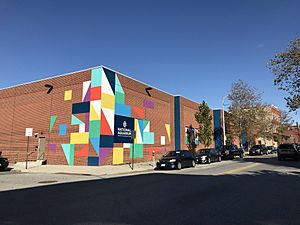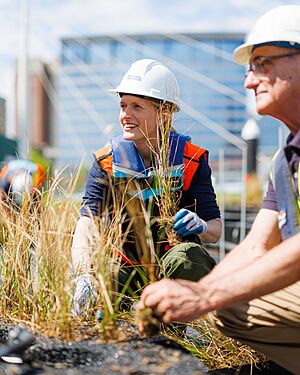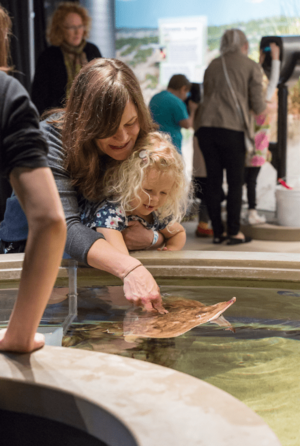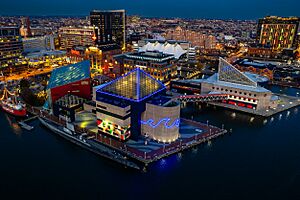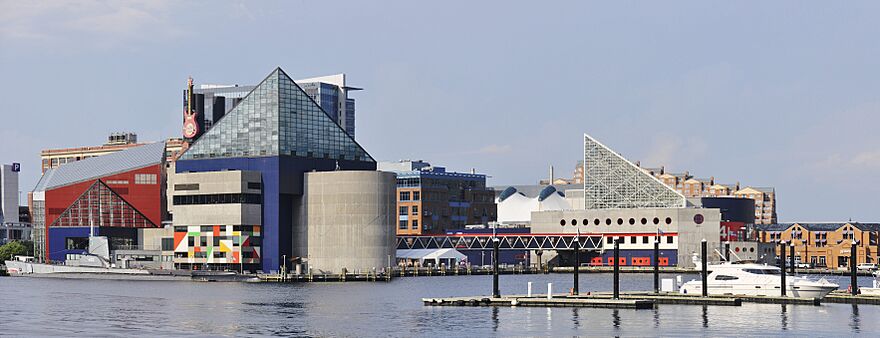National Aquarium (Baltimore) facts for kids
 |
|
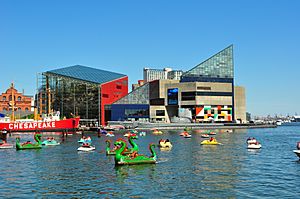
The National Aquarium (angular original building with glass pyramid top of 1981, rear right, and 2005 north extension to its left) lies near two of four historic museum / exhibit ships of the Baltimore Maritime Museum on Piers 3 and 4 in the Inner Harbor area of Baltimore, including World War II submarine USS Torsk and Lightship Chesapeake.
|
|
| Date opened | August 8, 1981 |
|---|---|
| Location | 501 East Pratt Street Baltimore, Maryland 21202 United States |
| Land area | 250,000 sq ft (23,000 m2) |
| Coordinates | 39°17′04″N 76°36′25″W / 39.284398°N 76.606936°W |
| No. of animals | 17,000+ |
| No. of species | 750+ |
| Volume of largest tank | 1,300,000 US gallons (4,900,000 L) |
| Total volume of tanks | More than 2,200,000 US gallons (8,300,000 L) |
| Annual visitors | 1.5 million (2009) |
| Memberships | AZA |
The National Aquarium in Baltimore is a super cool place to explore the underwater world! It's a nonprofit aquarium located right in the Inner Harbor area of downtown Baltimore. It first opened its doors on August 8, 1981.
This amazing aquarium is a huge hit, attracting about 1.5 million visitors every year. It's the biggest tourist spot in Maryland! Inside, you'll find over 17,000 animals from more than 750 different species. They live in tanks holding over 2.2 million gallons of water. The National Aquarium's main goal is to inspire people to protect the world's amazing water creatures and their homes.
The aquarium has many exciting exhibits. These include a tropical rain forest, a huge coral reef, a shark tank, and the "Australia: Wild Extremes" area. There's even a "4D Immersion Theater" for an extra fun experience. The aquarium also has a special area for marine mammals where you can see six Atlantic bottlenose dolphins. Most of these dolphins were born right there at the aquarium!
For a while, the National Aquarium in Baltimore worked together with an older aquarium in Washington, D.C.. They were like one big National Aquarium with two locations. But in 2013, the Washington, D.C. location closed. All its animals moved to the Baltimore aquarium.
Contents
- History of the National Aquarium
- Protecting Our Water World
- Exploring the Exhibits
- Working with the Washington, D.C. Aquarium
- How the Aquarium is Run
- Awards and Recognition
- Images for kids
History of the National Aquarium
How the Aquarium Started
The idea for the National Aquarium began in the mid-1970s. The mayor of Baltimore, William Donald Schaefer, and a city official, Robert C. Embry, visited the New England Aquarium in Boston. They were so inspired that they thought Baltimore should have its own aquarium. They believed it would be a great addition to the city's Inner Harbor area.
In 1976, people in Baltimore voted to support building the aquarium. Construction started on August 8, 1978, on Pier 3 in the Inner Harbor. Even though no money from the U.S. government was used to build it, the United States Congress officially called it the "national aquarium" in 1979.
Opening and Expansion
The National Aquarium opened to the public on August 8, 1981, after three years of building. Its first design was created by Peter Chermayeff. Years later, a new glass building was added. This expansion, called the Glass Pavilion, started being built on September 5, 2002. It opened on December 16, 2005. This new part is very tall, reaching 120 feet high!
Protecting Our Water World
The National Aquarium is a leader in protecting aquatic life and habitats. In 2011, it became the Maryland partner for the National Wildlife Federation. The aquarium works hard to clean up the Chesapeake Bay Wetlands.
Marine Animal Rescue Program
One of their most important programs is the Marine Animal Rescue Program (MARP). This team rescues, helps heal, and then releases marine animals back into the wild. They have successfully saved and returned many animals. These include seals, dolphins, porpoises, pilot whales, sea turtles, and even a manatee!
Research and Green Efforts
The National Aquarium also has a Conservation Center, started in 2009. This center does research to solve big problems facing ocean and coastal areas. They study things like ocean health and how to grow seafood in a sustainable way. They also track mercury levels in dolphins and study the effects of oil spills.
The aquarium is very committed to being "green." In 2011, it won an award for its strong commitment to sustainable practices. It uses a large solar farm in Cambridge for about 40% of its power. This helps reduce carbon dioxide, which is good for the environment.
Exploring the Exhibits
The National Aquarium has two main buildings: the Pier 3 Pavilion and the Pier 4 Pavilion. Each one offers unique and exciting experiences.
Pier 3 Pavilion: A Journey Through Water Worlds
This main building has five levels, each with different exhibits. You can travel from the shallow waters to the deep ocean!
Level 1: Blacktip Reef
This huge habitat holds 265,000 gallons of water. It looks like a reef in the Indo-Pacific ocean. You can see it from many angles, including a cool pop-out window. It's home to 69 species of fish, including blacktip reef sharks, emperor angelfish, and zebra sharks. A famous resident was Calypso, a 500-pound green sea turtle who lived there for many years after being rescued. Another green sea turtle named Kai joined the exhibit in October 2020.
Level 2: Maryland: Mountains to the Sea
This level shows animals that live in Maryland. You'll feel like you're traveling down a Maryland stream. It starts in the Allegheny Mountains and goes all the way to the Atlantic ocean shelf. You can see wood turtles, American bullfrogs, diamondback terrapins, and many types of fish.
Level 3: Surviving Through Adaptation, Living Seashore
Here, you'll learn how animals adapt to survive. For example, the electric eel can shock its prey. The peacock mantis shrimp has super strong claws! Other animals include lined seahorses and longnose gar.
The "Living Seashore" exhibit has two touch pools. Here, you can gently touch animals like little skates, Atlantic stingrays, and Atlantic horseshoe crabs. It's a great way to explore the Mid-Atlantic shoreline.
Level 4: North Atlantic to the Pacific, Amazon River Forest
This level takes you to different water habitats around the world. You'll see seabirds like Atlantic puffins in a sea cliffs exhibit. There's a Pacific coral reef with colorful fish like percula clownfish. You can also explore a kelp forest with garibaldis and horn sharks.
The "Amazon River Forest" exhibit lets you see animals both in the water and in the trees above. Look for Arrau turtles, emerald tree boas, and smooth-fronted caimans. You'll also spot fish like blue discus and silver arowana.
Level 5: Upland Tropical Rain Forest, Hidden Life
This level feels like you're in the Amazon rainforest. You can watch birds from high platforms. There's also a cave with glass displays of reptiles and amphibians. Some of the animals you might see are Golden lion tamarins, Scarlet ibis, Yellow-headed amazon parrots, and Linnaeus's two-toed sloths.
Atlantic Coral Reef
This huge 335,000-gallon tank shows what an Atlantic coral reef is like. It's full of over 100 different species. You can spot a green moray eel, queen triggerfish, black grouper, and a Kemp's ridley sea turtle.
Shark Alley: Atlantic Predators
This 225,000-gallon, ring-shaped tank is home to larger ocean animals. It's designed to look like the deeper parts of the Atlantic coral reef. Here, you can see sandbar sharks, sand tiger sharks, nurse sharks, and even a largetooth sawfish.
Pier 4 Pavilion: Dolphins and Jellies
This smaller building, opened in 1990, is where the marine mammals live. It also has a special exhibit for jellyfish.
Dolphin Discovery
This exhibit is home to the aquarium's six bottlenose dolphins. You can watch them during training, feeding, and play times. Experts are often there to answer your questions. The dolphin family includes two males (Foster, Beau) and four females (Spirit, Chesapeake, Bayley, Jade). Chesapeake was the first dolphin born at the aquarium in 1992.
The National Aquarium is planning to move its dolphins to a large, protected seaside sanctuary in Florida or the Caribbean by 2026. This will be a new kind of home for dolphins in human care.
Jellies Invasion: Oceans Out of Balance
Opened in 2009, this exhibit shows nine different species of jellyfish. It also teaches you how jellyfish can be "bioindicators." This means they are sensitive to changes in their environment. They can show us if there's pollution, climate change, or other problems in an ecosystem. You can see Atlantic sea nettles, Pacific sea nettles, Lion's mane jellyfish, and blue blubber jellyfish.
Australia: Wild Extremes (Glass Pavilion)
This exhibit is like a giant walk-in aviary. Many birds can fly freely around you! It shows a river gorge in Australia and has pools with Australian aquatic life. The exhibit teaches about the extreme weather in this part of Australia: fire, drought, and flood. You can see over 1,800 native animals, including freshwater crocodiles, turtles, snakes, and lizards.
The Glass Pavilion opened in December 2005. It has a 35-foot waterfall that you can even see from outside the aquarium! Inside, you'll find Aboriginal artwork that shows how the native people understand their land. Some of the animals here are Laughing kookaburras, Rainbow lorikeets, Pig-nosed turtles, and Australian lungfish.
Working with the Washington, D.C. Aquarium
The National Aquarium in Washington, D.C. was a separate aquarium that opened way back in 1873. For a while, starting in 2003, the Baltimore aquarium helped manage the Washington, D.C. location. They worked together as one organization with two sites. However, the Washington, D.C. aquarium closed permanently on September 30, 2013. About 1,700 animals from that location moved to the National Aquarium in Baltimore.
How the Aquarium is Run
The National Aquarium is a nonprofit public aquarium. The city of Baltimore owns the building and land. But the aquarium itself is managed by a nonprofit group called National Aquarium, Inc. This group has a volunteer Board of Governors and a paid staff. They work hard to make sure the aquarium can support itself through ticket sales and donations.
Awards and Recognition
The National Aquarium has received many awards! In 2012, the Travel Channel named it one of the best aquariums in the United States. Coastal Living magazine also called it the #1 aquarium in the U.S. in 2009. It has also won "Best Attraction" and "Best Place to Take Kids" awards from the Baltimore City Paper.
Images for kids
-
Blacktip Reef with stingrays and Blacktip reef sharks


